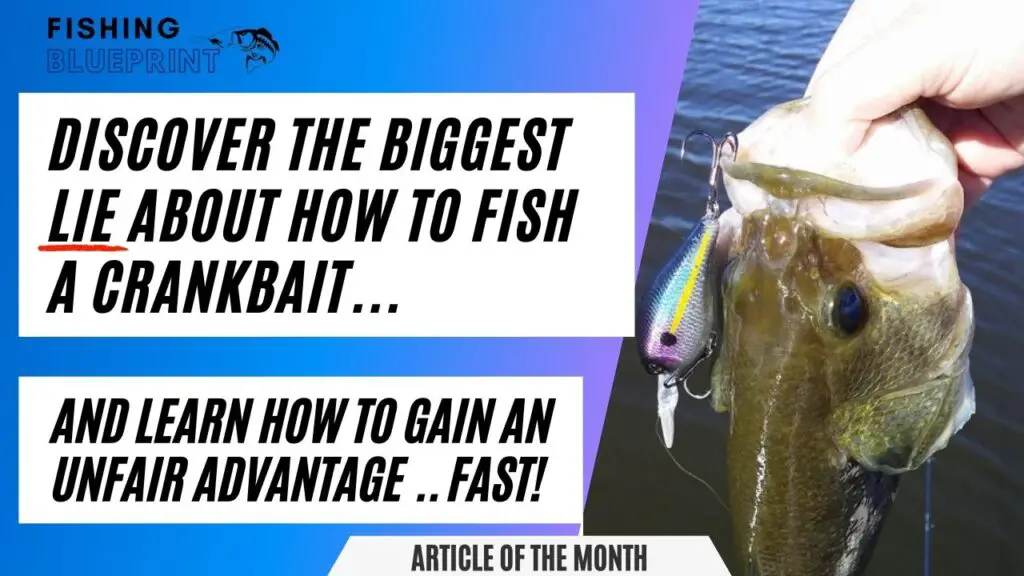How To Fish Trinity Lake | Your Trinity Lake Fishing Report
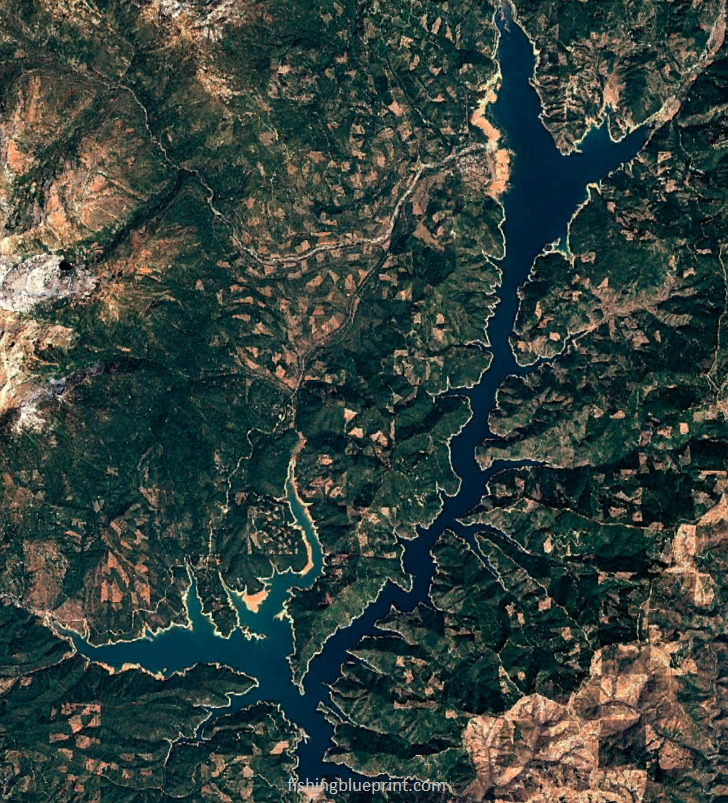
Trinity Lake is one of the largest reservoirs in California that sits 268 miles away from San Francisco, or 595 miles away from Los Angeles.
Overall it’s a relatively quiet lake for its size and is known as one of the last “fisherman’s lakes” in California. It’s farther and more out of the way, and there are other more commercialized lakes closer to the big cities. In this post you’re going to be given the blueprint to fish this lake.
So what are the best tips for fishing Trinity Lake? There are three important factors you must know if you want to know how to fish Trinity Lake successfully. First, you need to know what kind of fish is in Trinity Lake. Second, it’s important for you to know which part of the lake each species can be found. Lastly, knowing what are the best baits that work on Trinity Lake is vital. However, tactics, baits, and locations will be different for each type of fish that you target. So let’s talk about the steps you need to take in order to give you the best chance of catching a fish on Trinity Lake.
Key Takeaways
This lake gives locals and visitors the opportunity to test their luck in catching one of the many game species this lake has to offer, such as trout, salmon, bass, catfish, bluegill, and much, much more!
Here’s the most recent and updated Trinity Lake Fishing Report – it gives you a quick and easy list of some really good fishing spots. If you’re looking for more detail on how to fish each spot scroll down into the article.
- Trinity Dam
- Captains Point
- Tailing Pile Area
- Papoose Arm
- Little Bear Gulch
Here are some additional fast and helpful tips just for you:
- The easiest way to fish this lake is by boat, but there are areas to fish from the bank, or by kayak or float tube.
- There are public boat ramps to use.
- Camping and RV parking is available.
- You can buy tackle and groceries at the lake or at one of the tackle shops in the list below.
About Trinity Lake
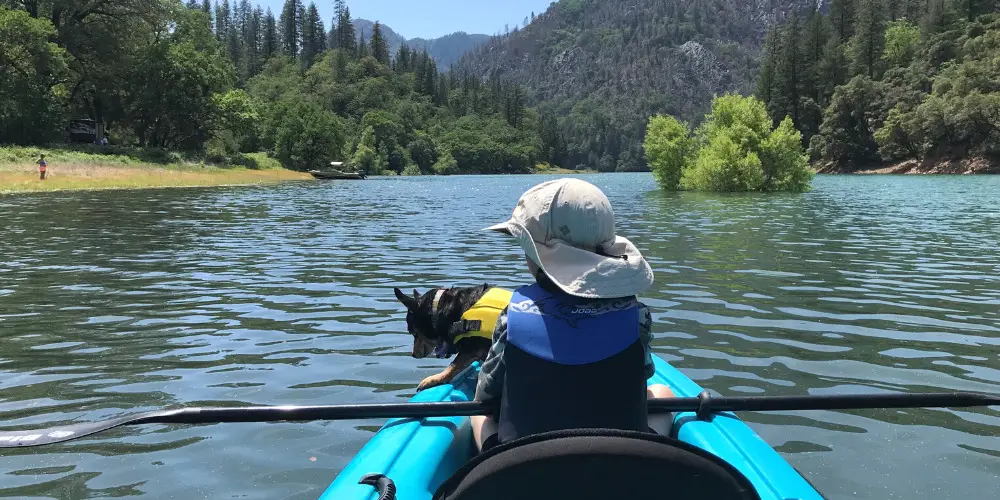
Trinity Lake’s main function is a part of California’s Central Valley Project, which supplies water for agriculture and generates hydroelectric power in the Central Valley.
Trinity Lake is a deep body of water with the average depth being 120 feet and a maximum depth of 390 feet when the lake is completely full.
Fishing Trinity Lake can be incredible when you have over 141 miles of shoreline and over 17,280 acres to fish.
Important Lake Warnings
Algae blooms may be present which may affect fishing, swimming, and water contact in general.
According to parks.ca.gov, “every one of California’s new laws requires boat operators to have a California Boating Card. The card is required for anyone under the age of 41 to operate a boat in California’s waters.”
If you are fishing and camping, fire bans may be in effect due to the ongoing drought conditions.
What Kind Of Fish Are In Trinity Lake
- Largemouth Bass
- Smallmouth Bass
- Rainbow Trout
- Brown Trout
- Kokanee (landlocked Sockeye Salmon)
- Chinook Salmon (aka King Salmon)
- White Catfish
- Bullhead Catfish
- Sunfish
Trinity Lake Fishing Tips & General Strategies
It can be a challenge to break down this body of water… So that’s why I created this Trinity Lake Fishing Report to help you to easily start catching fish fast!
Located in the Shasta-Trinity National Forest, this bad boy stretches over 17,280 acres, offering plenty of room for you to drop the hammer on some lunkers.
The majority of anglers will travel to Trinity Lake Lake to either fish for bass or trout.
This lake used to be a closely guarded secret. Known only by the locals because its basically out in the middle of nowhere.
However, recently anglers have been sharing their catches on social media and this lake is quickly becoming known to grow some monster smallmouth bass!
Buckle up, fellas! We’re talking about Trinity Lake in California, a prime location for anglers to wet a line and bag some hawgs. Let’s dive in and explore this fisherman’s oasis.
Water Clarity:
- Trinity Lake’s water clarity can vary, but generally, it’s got that gin-clear look, making it a sight fisherman’s dream come true.
- You’ll find visibility ranging from 5 to 15 feet depending on the time of year, weather conditions, and lake levels.
- When the lake’s visibility gets a little murky, don’t fret! Break out those spinnerbaits, crankbaits, or flipping jigs to entice those bass hiding in the shadows.
Structures and Cover:
- Trinity Lake is chock-full of structures and cover that’ll make any bass angler’s heart race. Check out these prime spots to snatch up some slaunches:
- Rocky Points: Perfect for smallies, target these points with finesse techniques like drop-shotting, ned rigs, or shaky heads.
- Submerged Timber: A haven for largies, flip and pitch jigs or Texas-rigged soft plastics into these wood-infested zones.
- Isolated Stumps: These lone wolves are perfect ambush points for bass. Work your way around them with spinnerbaits, jerkbaits, or topwater lures.
- Steep Bluffs: Often overlooked, these vertical walls can hold spotted bass year-round. Bust out your deep-diving crankbaits or football jigs to tap into this gold mine.
- Weed Beds: They’re not just for hiding from your buddy who “forgot” to bring the snacks. Use swim jigs, chatterbaits, or frog lures to entice big bass hiding in the vegetation.
- Trinity Lake is chock-full of structures and cover that’ll make any bass angler’s heart race. Check out these prime spots to snatch up some slaunches:
Springtime Fishing update
Buddy, got some intel for you on the spring fishing scene. You better gear up and get ready to tackle the water. Here’s what’s happening:
Water Temperature:
- Ranging from mid 50’s to low 60’s. Be ready for varying temps, they’re gonna test your angling skills.
Water Clarity:
- It’s a mix, my man. From clear (4+ foot visibility) to stained (2-4 foot visibility) and even muddy (0-2 foot visibility). Gotta keep an eye on it and adjust your game plan.
Wind and Weather Conditions:
Spring’s playing games with us, bro. Expect:
- Calm mornings that could turn into windy afternoons
- Overcast days and even some light rain
- Don’t forget those sunny, warm days – perfect for catching some rays while you reel ’em in
Now, let’s talk about the juicy stuff – techniques, baits, and where those fish are hiding:
Smallmouth Bass:
- Crankin’ and rippin’ baits are getting some bites, but don’t expect huge numbers.
- Try hitting steep banks with stumps and fallen trees.
- Topwater action is heating up – Zara Spooks are making smallies go bananas.
Largemouth Bass:
- Dropshot with a Roboworm in morning dawn, but remember: SLOW is the way to go.
- Senkos and Roboworms are also producing results.
- Focus on 4-16 ft of water, and don’t forget those submerged trees.
Trout:
- They’re loving crankbaits, spinners, and spoons, so throw some of those in your tackle box.
- A lot of fish are being caught behind flashers or cowbells.
- Nice-sized trout are schooling and are super active.
- Seems like they’re hanging out around the south end of the lake.
So, there you have it, dude. The spring fishing report summary is all laid out for you. Grab your gear, hit the water, and give it your best shot. And hey, don’t forget to practice catch and release – let’s keep those fish populations healthy for the next generation of anglers. Tight lines, my friend!
Trinity Lake – Summer Fishing update
Hey fellas, I’ve got some fresh intel on the summer fishing scene at Trinity Lake. I’ve gathered even more info from those anglers who’ve been out there slaying ’em. So grab your gear, and let’s dig deeper into the techniques, baits, and hotspots that’ll make this summer unforgettable:
Water Temperature:
- Ranges from 68°F to 79°F. It’s pretty warm out there, so the fish are active.
Water Clarity:
- Mostly clear with 4+ foot visibility, but you might encounter some stained areas with 2-4 foot visibility. Keep an eye out for those sweet spots.
Wind and Weather Conditions:
- Be prepared for some unpredictable weather. You might face light rain, high winds, and even thunderstorms during this season. But don’t let that scare you off – the fish are still biting!
Techniques and Baits:
Largemouth Bass:
- Senko’s wacky style is getting the job done. Colors like green pumpkin black flake, watermelon red flake, and even rainbow trout colored senkos are getting the attention of those lunkers.
- Dropshotting and dragging tubes in oxblood and salt & pepper colors are also producing results. Rig a 4-6″ finesse worm or leech for better hookups.
- Jigs and spinnerbaits in crawfish patterns, and chatterbaits with swimbait trailers are getting the big boys to strike.
Smallmouth Bass:
- Dropshotting with Roboworm Reapers is the ticket. Crankbaits like Speed Traps are also effective, especially when targeting shoreline structure and weedlines.
- Topwater lures like Spooks, Pop-Rs, and swimbaits are getting some serious blowups from the smallies. Don’t forget to try buzzbaits and whopper ploppers early in the morning or late in the evening.
- For bigger fish, go deeper and fish in 20-35 feet of water with football jigs, Carolina rigs, or deep-diving crankbaits.
Trout and Bluegill:
- Incidental catches are happening, so you might get a nice surprise. Trout are biting on largemouth bass techniques. For dedicated trout action, try trolling with small spoons, Rapalas, or spinners.
- Bluegill are going crazy for nightcrawlers, red worms, and wax worms under bobbers, as well as small jigs and poppers.
Fishing Hotspots:
Largemouth Bass:
- Brush piles where creeks flow into the lake are a gold mine. Keep your distance and have fun! Also, check out submerged timber, docks, and laydowns for bass ambush spots.
- Shallow rock piles are also a good bet. Target rocky points, ledges, and humps near deeper water.
Smallmouth Bass:
- Points near the main lake (both inside and outside) are where the action’s at. Work those areas with a mix of reaction baits and finesse techniques.
- East Fork and tailings are also producing some nice catches. Keep an eye out for boulders and chunk rock areas that provide cover and ambush points.
Trout and Bluegill:
- Trout can be found in deeper, cooler water around 20-40 feet. Look for them near underwater structure or off steep, rocky drop-offs.
- Bluegill hang out in shallow coves, around weed beds, and near docks. Target them with small baits and lures.
But Where Are The Best Places To Fish At Trinity Lake?
And in no particular order here is that list of the best fishing spots at Trinity Lake.
DISCLAIMER: The material provided is for general information purposes only. It’s important to understand that any information provided in this article can change at any time. Any maps or graphics featured are not to be used as navigational aids. Fishing Blueprint will not be responsible for any personal injury or property damage from any misuse of the maps or graphics provided. It’s completely impossible to give you every single spot where you can potentially catch a fish. But, what this list does do is to give you a helping hand and narrow down to the most productive fishing spots.
Trinity Dam
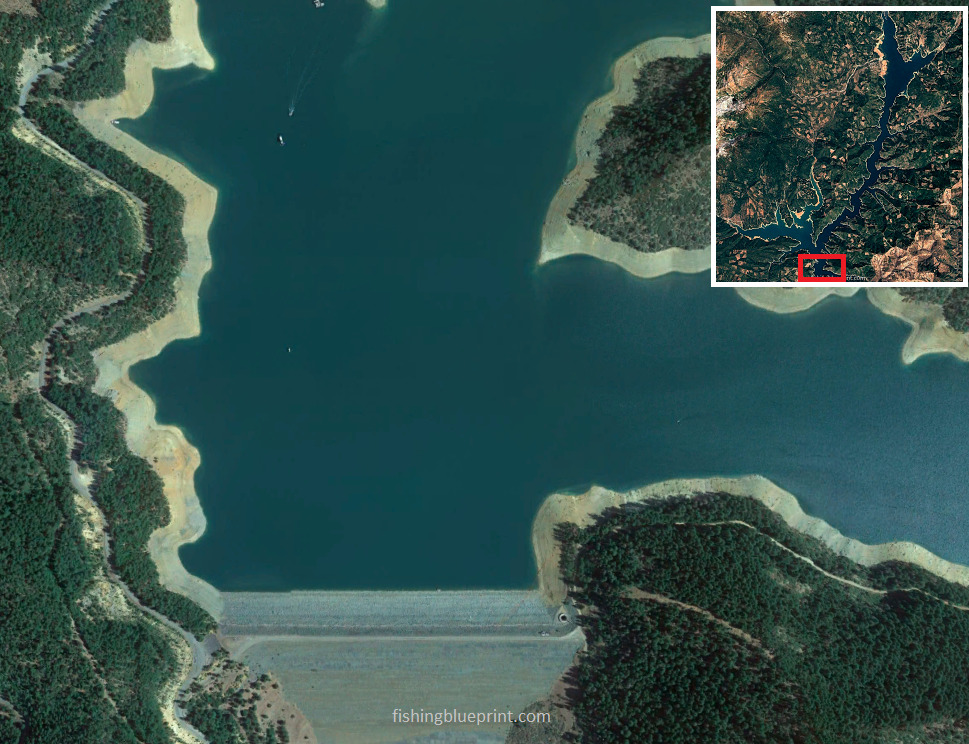
This spot is awesome and can be fished all year long.
If you’re gunning for salmon, lake trout, rainbow trout, brown trout, stick to the area just outside the buoy line of the dam.
However if you’re targeting bass or crappie, focus on Squaw Creek cove, especially when the water is low.
Make sure you’re rigged up right. Match your gear to your target. Lighter tackle for trout, beefier stuff for bass and salmon.
This area can be fished all day for different fish species.
Remember, the early bird gets the worm – Sunrise and sunset are prime time for bass and trout. As a bonus, if you’re chasing salmon, they might be more active during brighter hours.
Use a quality sonar to scan for suspended schools of salmon and trout. You can also scan for submerged structures for fish. Cast around submerged trees and rocky shelves for bass and crappie in Squaw Creek cove.
Scan the deepest pockets of water to shine the light on hiding elusive lake trout and brown trout.
Watch the Wind. Trinity Lake Dam can get pretty gusty, so keep an eye on the weather and be prepared to adapt your tactics. Invest in a drift sock to slow your drift and keep your lure in the strike zone longer.
By the way, we found a really good quality drift sock made by Mythik Outdoors, and best of all they’re sold on Amazon.com. Go here to learn more about drift socks and read the reviews from actual customers.
Look carefully at this spot using a topographic map…
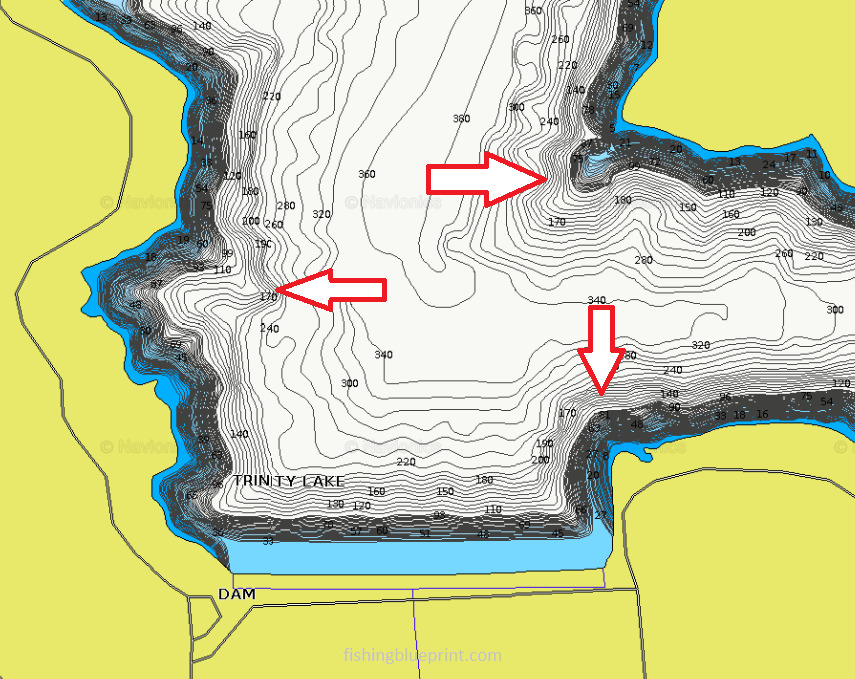
The above picture will show you some of the structure the fish love to hold around; points, steep walls, and shelves with steep ledges.
Oh, before I forget, did you know that there is an article about how to troll for salmon, trout, and kokanee the right way? Go here to find out more.
Located: south end of lake
Structural features: deep open water, ledges, and drop offs
Best species to target: King salmon, lake trout, kokanee salmon, rainbow trout
Most effective way to fish this spot: Boat, kayak, float tube
Captains Point
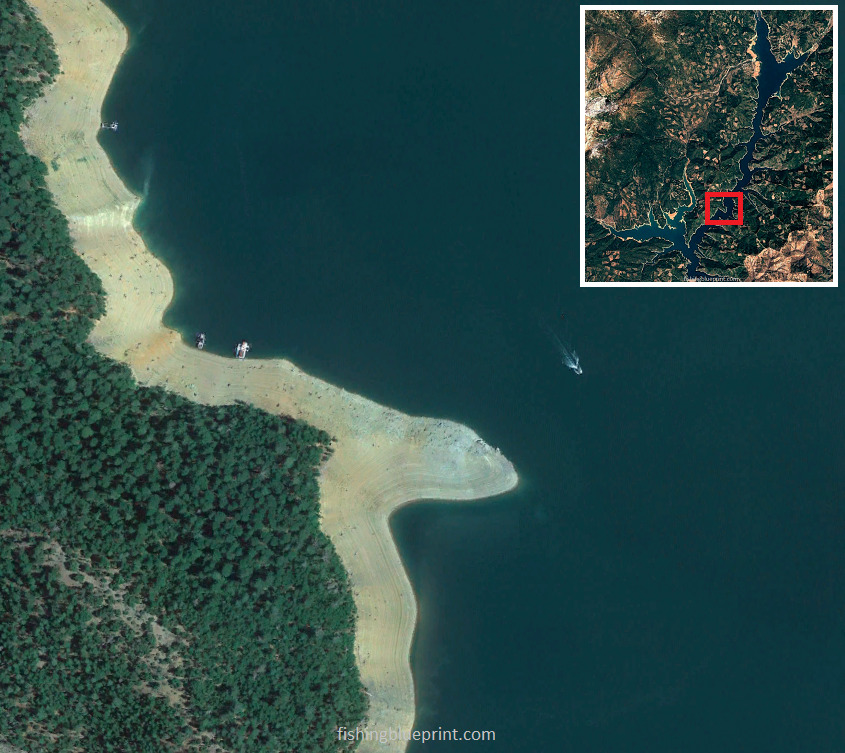
If you analyze the banks of Captains Point you’ll notice isolated patches of chunk rock banks.
The banks can range from moderate to relatively steep and can range from large boulders, to chunk rock, to pea-sized substrate.
Look closely at this spot under low water level…
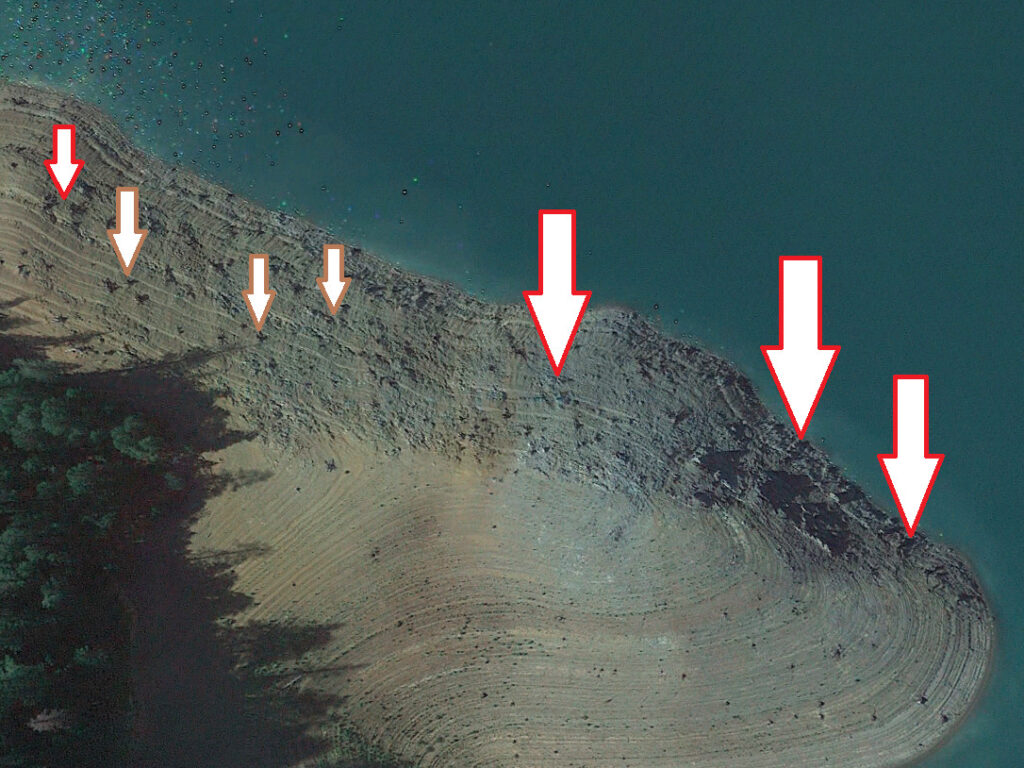
The red arrows represent the rocky patches, the brown arrows represent old tree stumps. Both will attract bass, especially in the summer.
Look carefully at this spot using a topographic map…
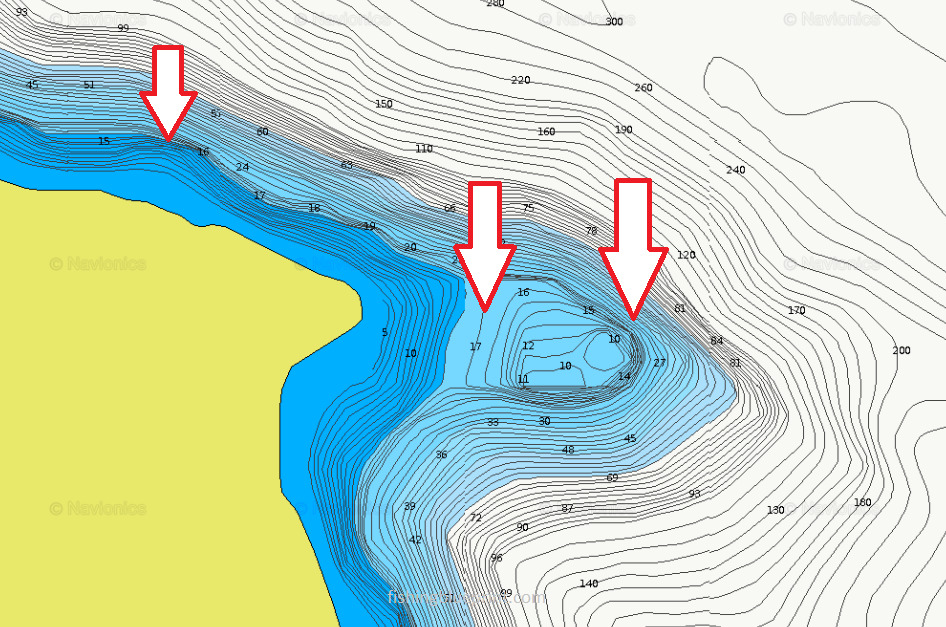
Studying the topographic map you’ll see the sharp main channel turn as well as long point the extends far into the lake.
Additionally, you can see the shelf on the point and the hump at the end of the point. Lastly, you’ll see a small shelf and drop off on the inside bend.
All of these spots will attract fish. Carefully, scan this area with your sonar and fish efficiently.
Side scanning this area for active fish such as all species of trout and smallmouth bass should be a must if you plan to fish this lake.
Surprisingly, this area remains relatively quiet for recreational fishing traffic, due to the fact that most other anglers will either focus on the north or south end of the lake.
Located: Mid-lake
Structural features: Steep rocky banks, drop offs, and ledges
Best species to target: Bass, trout
Most effective way to fish this spot: Boat
Tailing Pile Area
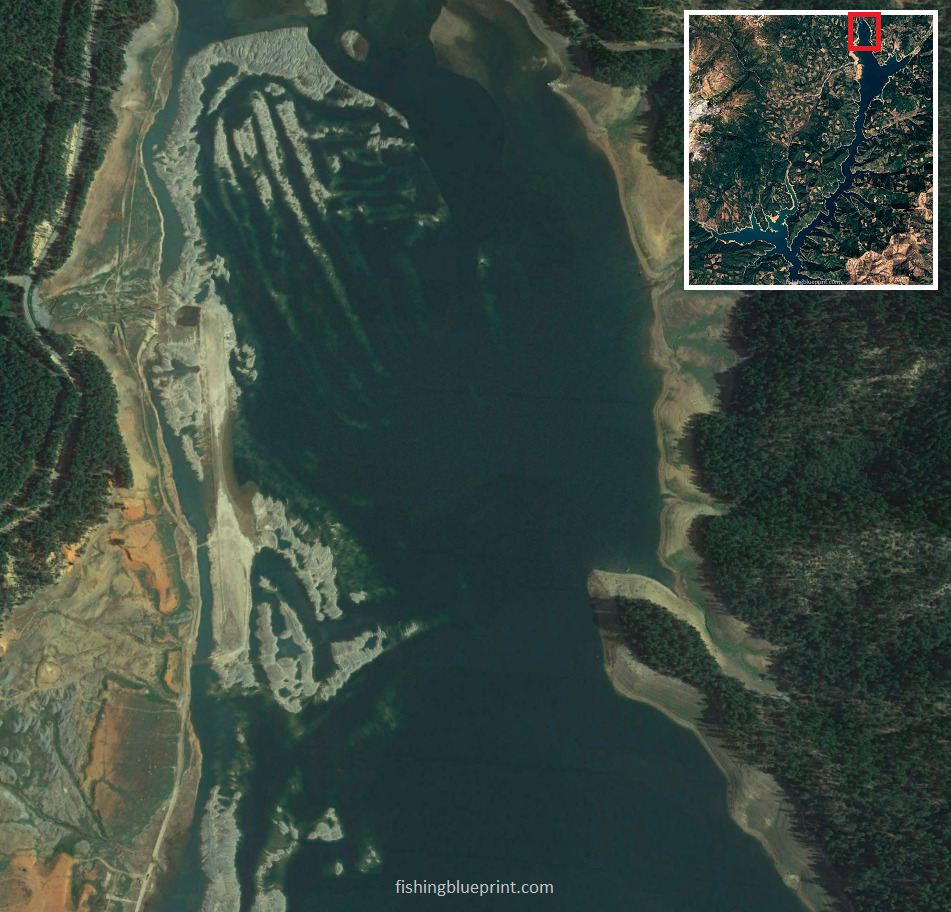
This spot is essentially a large cove off with a TON of structure!
It gives the angler many different structures you can target and fish, such as multiple points, ledges, ridges, drop offs, rock piles, holes, and humps.
The most productive areas will be where any channels or ditches are close to another type of structure (such as points, ledges, ridges, drop offs, or humps), or close to some form of cover (brush piles, laydowns, vertical standing timber, roadbeds, docks, bridge pilings or any other form of artificial structure).
Areas like these are phenomenal during the spring and in the fall.
Before trying to fish everything, be sure to take some time and scan these areas first with your fish finder to see if there are any bait or bass relating to that particular spot. If you see bait or bass in the spot then fish it.
Look closely at this spot under low water level…
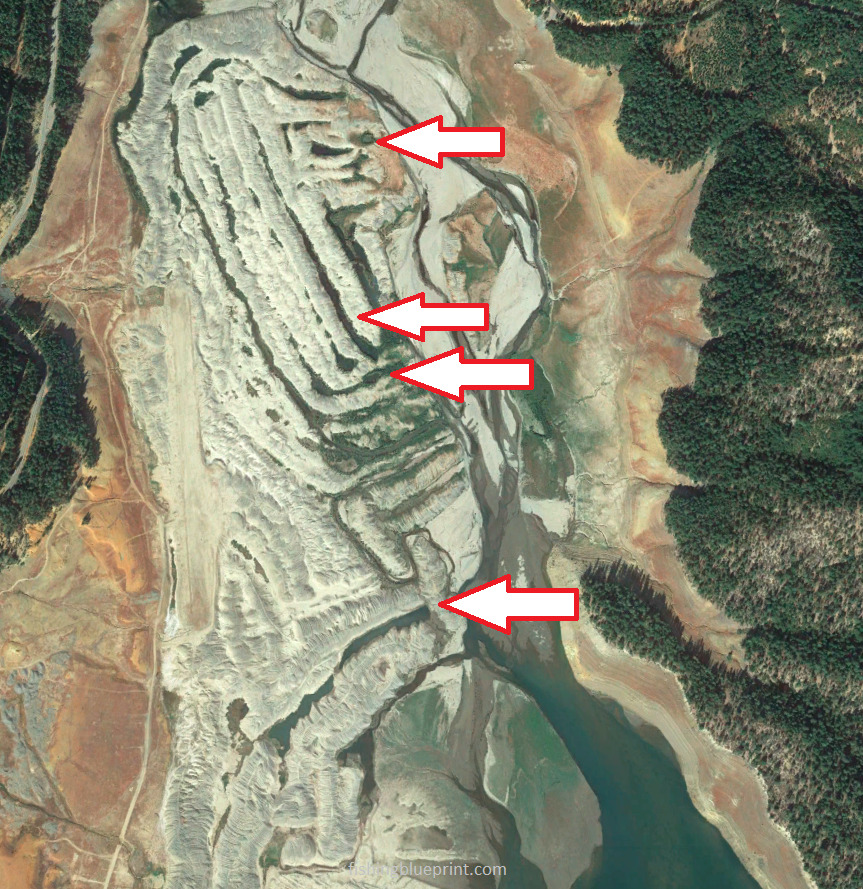
Effective bass baits for this area include: topwater lures, flutter spoons, buzzbaits, crankbaits, soft plastic swimbaits, spinnerbaits, chatterbaits, jerkbaits, swim jigs, hair jigs, and underspin jigs when the bass are aggressive.
If the bass are timid, then drop shot, tubes, Ned rig, Neko rig, Mojo rig, Carolina rig and football jigs are awesome choices.
Located: upper section of the lake
Structural features: channel swing cove, points, hard structure
Best species to target: largemouth bass, smallmouth bass, spotted bass, crappie, catfish
Most effective way to fish this spot: boat
Papoose Arm
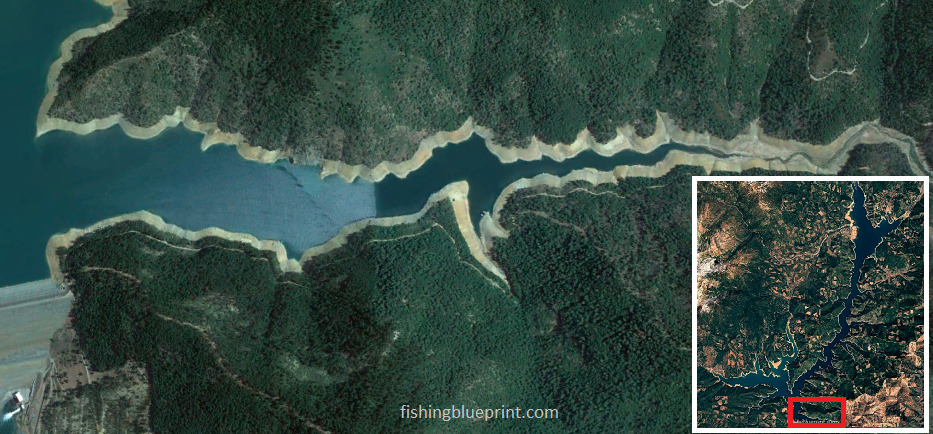
This long straight cove features a deep channel fed by several feeder creeks.
A really great hallmark about this fishing spot are all the ledges and boulder/rock piles. Created by the dam construction crews, the ledges and drop offs offer a unique type of structure not seen anywhere else on the lake.
Scan the intersections for ledges, drop offs, boulders, rock piles, ridges associated with the two intersecting channels.
Look closely at this spot under low water level. This is just one of several spots like this…
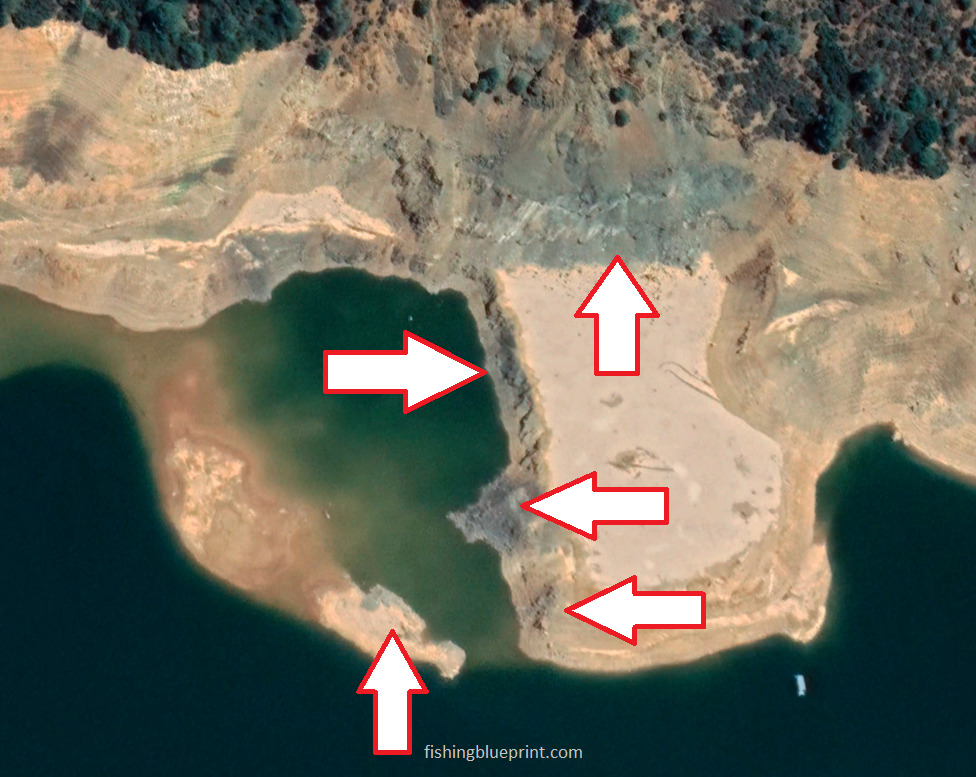
This particular spot on the Papoose arm has huge cliffs, ledges, a pit, and giant off shore rock piles.
Look carefully at this spot using a topographic map…
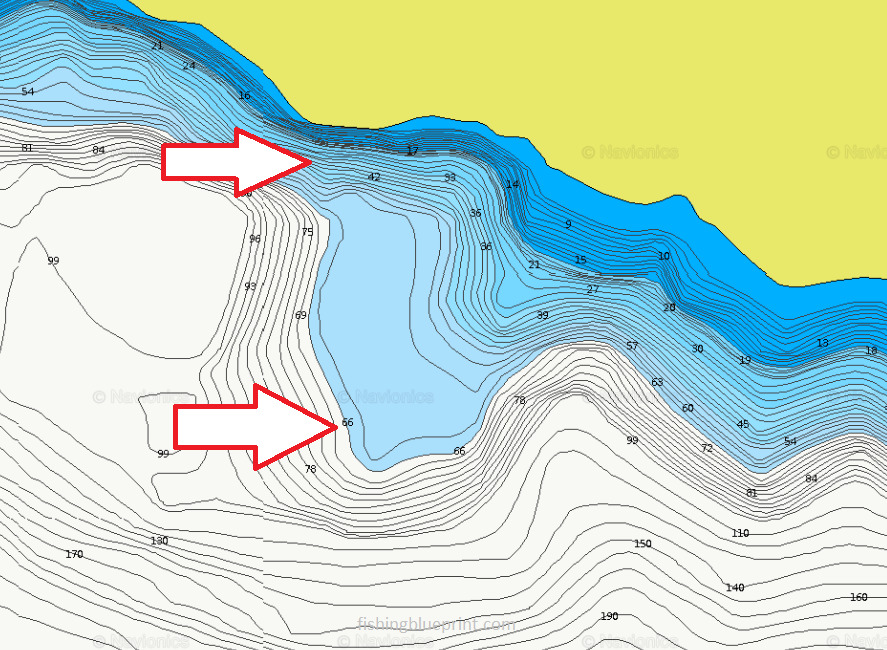
Located: southeast section of the lake
Structural features: cliffs, ledges, a pit, and giant off shore rock piles.
Best species to target: largemouth bass, smallmouth bass, spotted bass, crappie, catfish
Most effective way to fish this spot: boat
Little Bear Gulch
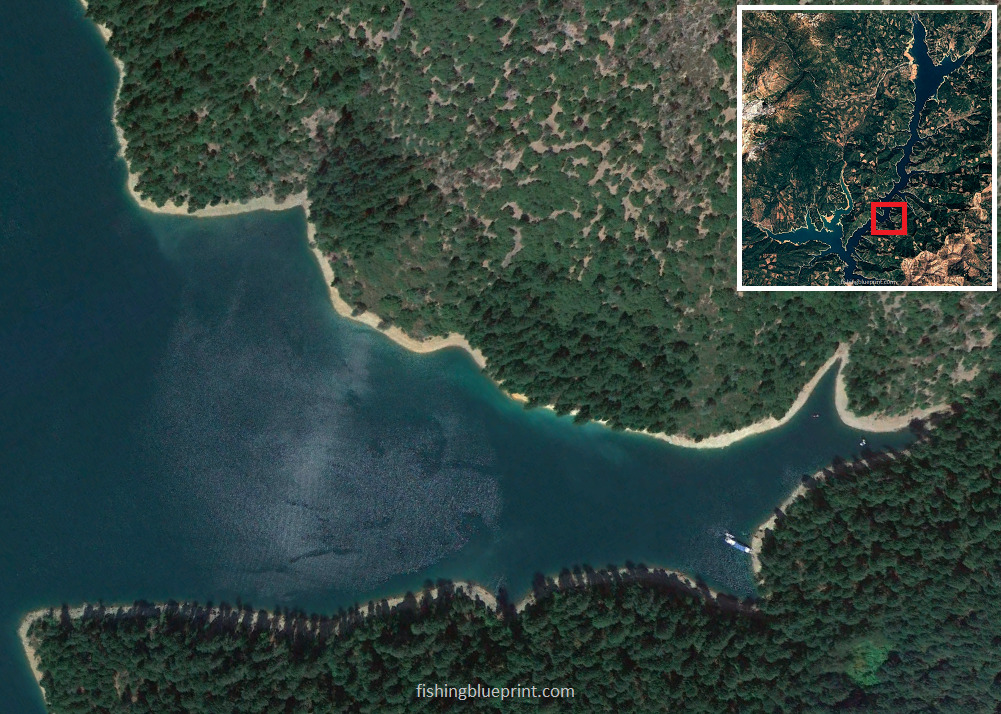
Small deep cove just off the main lake with several ditches that drain into it. However, the best number one feature about this cove is the rocky structure on the southern side.
Look closely at this spot under low water level…
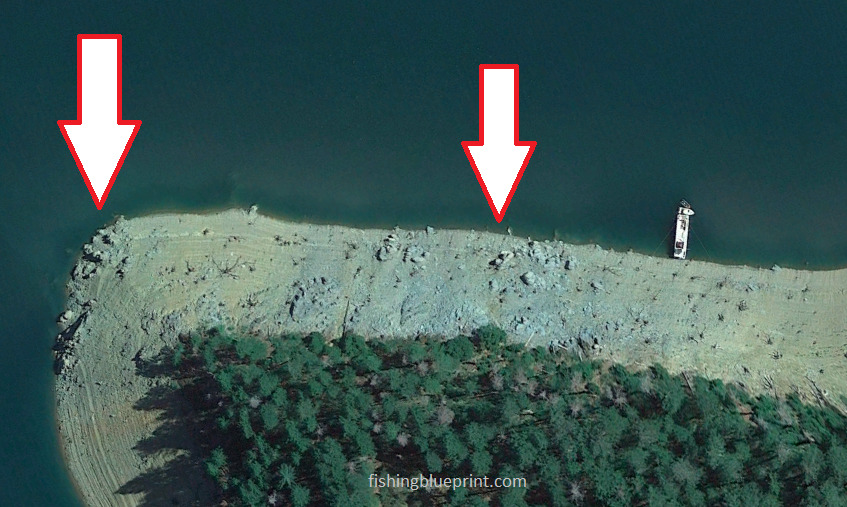
Look carefully at this spot using a topographic map…
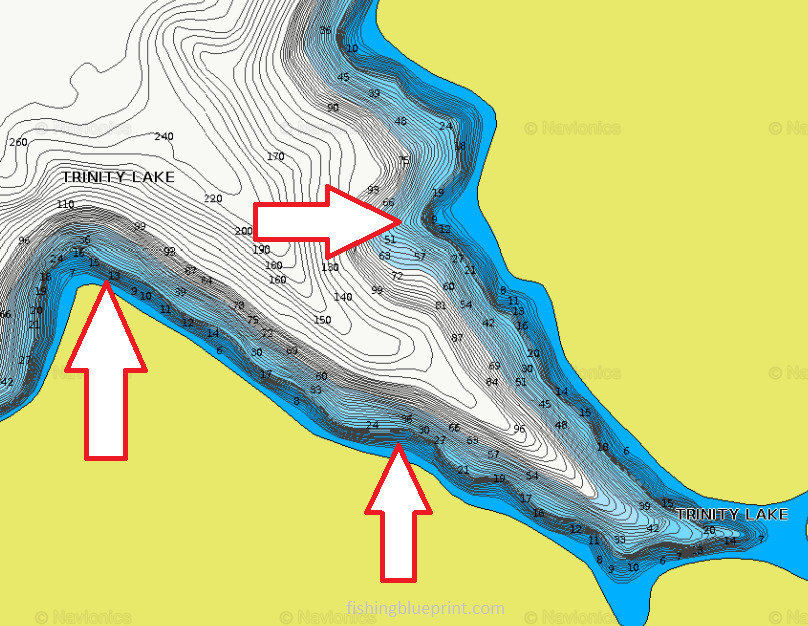
Located: East Fork – Trinity
Structural features: big patch of rock and boulder/ rock piles.
Best species to target: largemouth bass, smallmouth bass, spotted bass, crappie, catfish
Most effective way to fish this spot: boat
Boat Ramps at Trinity Lake
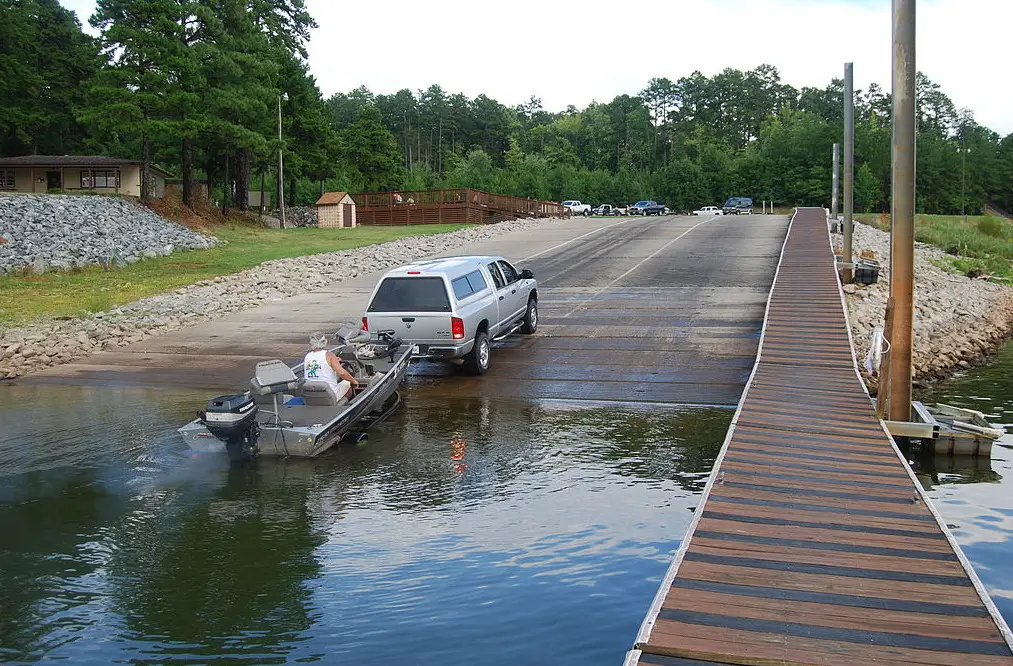
Fairview Boat Ramp
Trinity Dam Blvd, Lewiston, CA 96052
(530) 623-2121
Lanes: 2
Restrooms: Yes
Showers: no
Gas: no
Tackle, groceries, snacks available: no
Fish Cleaning Station: no
Camping nearby: Yes
Stuart Fork Public Boat Ramp
Trinity Alps Rd, Trinity Center, CA 96091
(530) 623-2121
Lanes: 2
Restrooms: Yes
Showers: no
Gas: no
Tackle, groceries, snacks available: no
Fish Cleaning Station: no
Camping nearby: Yes
Minersville Public Boat Ramp
Granite Peak Rd, Trinity Center, CA 96091
(530) 275-8113
Lanes: 2
Restrooms: Yes
Showers: no
Gas: no
Tackle, groceries, snacks available: no
Fish Cleaning Station: no
Camping nearby: Yes
Clark Springs Boat Ramp
Rainier Rd, Trinity Center, CA 96091
shastatrinitycamping.com
(530) 275-8113
Lanes: 2
Restrooms: Yes
Showers: no
Gas: no
Tackle, groceries, snacks available: no
Fish Cleaning Station: no
Camping nearby: Yes
Bowerman Boat Ramp
Guy Covington Dr, Trinity Center, CA 96091
(530) 275-8113
Lanes: 2
Restrooms: Yes
Showers: no
Gas: no
Tackle, groceries, snacks available: no
Fish Cleaning Station: no
Camping nearby: Yes
Trinity Center Boat Ramp
Mary Ave, Trinity Center, CA 96091
(530) 623-2121
Lanes: 2
Restrooms: Yes
Showers: no
Gas: no
Tackle, groceries, snacks available: no
Fish Cleaning Station: no
Camping nearby: Yes
Marinas at Trinity Lake
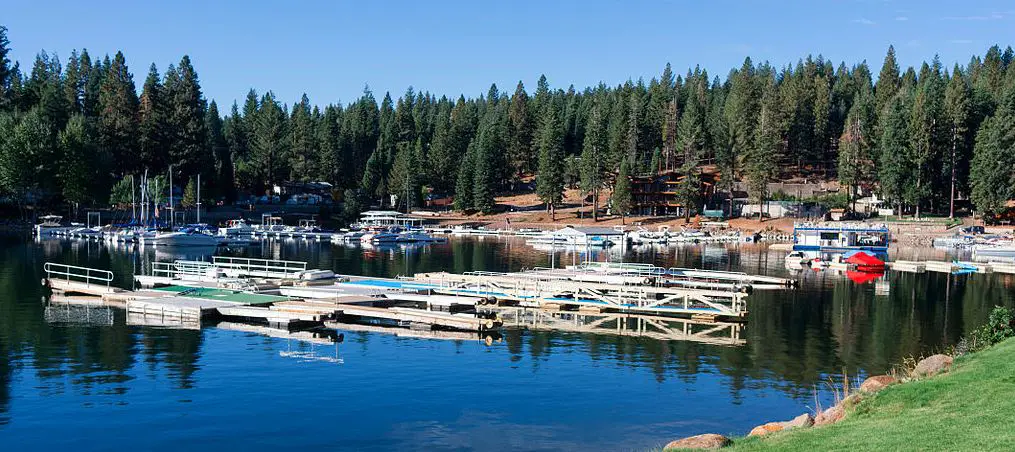
Trinity Alps Marina
1 Fairview Marina Dr, Lewiston, CA 96052
trinityalpsmarina.com
(530) 410-2354
Nearby boat ramp: Yes
Restrooms: Yes
Showers: no
Gas: Yes
Groceries/snacks available: Yes
Electric: No
Camping nearby: Yes
Trinity Lake Resort & Marina
45810 CA-3, Trinity Center, CA 96091
trinitylakeresort.com
(530) 286-2225
Nearby boat ramp: Yes
Restrooms: Yes
Showers: no
Gas: Yes
Groceries/snacks available: Yes
Electric: No
Camping nearby: Yes
Tackle Shops Near Trinity Lake
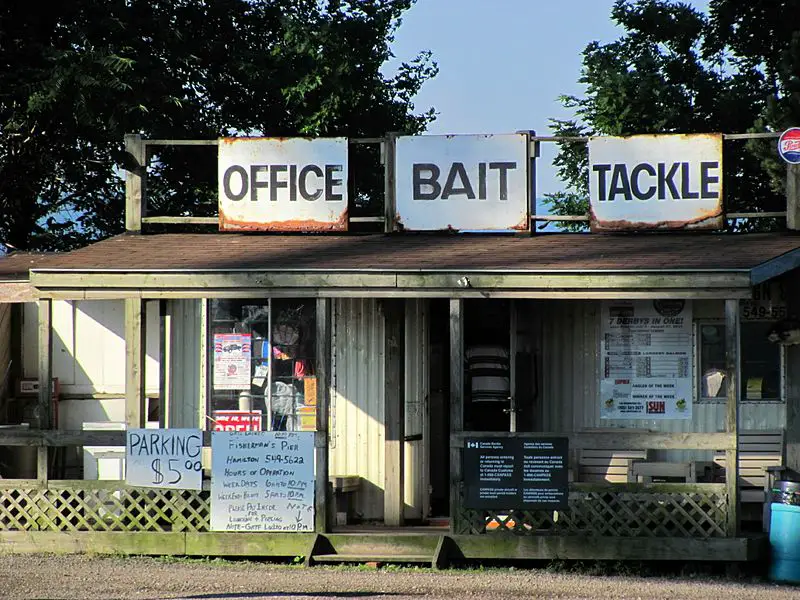
Lewiston Hometown Market
241 Lewiston Turnpike Rd, Lewiston, CA 96052
(530) 778-0500
Trinity Fly Shop
4440 Lewiston Rd, Lewiston, CA 96052
trinityflyshop.com
(530) 623-6757
Junction City Store
43380 CA-299, Junction City, CA 96048
junctioncitystore.com
Phil’s Fishing Tackle
3037 Twin View Blvd, Shasta Lake, CA 96019
philsprop.com
(530) 275-4939
Fishen Hole
3844 Shasta Dam Blvd, Shasta Lake, CA 96019
(530) 275-4123
Western Bait Farm
3211 Veda St, Redding, CA 96001
westernbaitfarm.com
(530) 246-0270
Shasta Lake Bait & Tackle LLC
3915 Shasta Dam Blvd, Shasta Lake, CA 96019
(530) 356-5575
Camping Near Trinity Lake
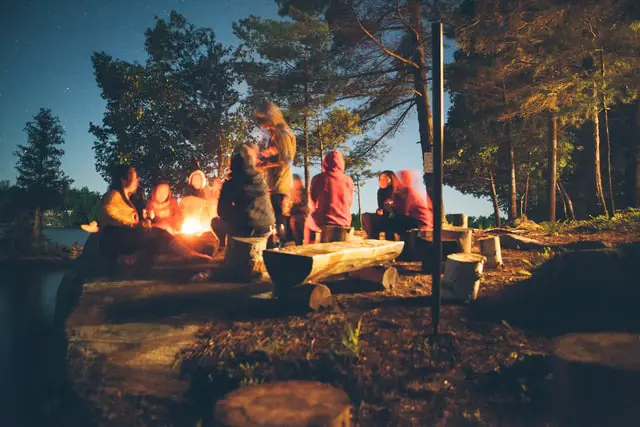
Trinity Lake is blessed with an abundant amount of campgrounds that cater to RVer’s, tent campers, and even boat-in campers
Most campgrounds offer visitors level parking, picnic tables and fire pits. The majority have bear-proof food lockers. Drinking water and flush toilets are provided.
Here is a list of both RV/tent campgrounds and boat-in campgrounds.
RV/tent campgrounds
Tannery Gulch Campground – Map & Reservations
Stoney Point Campground – Map & Reservations
Stoney Creek Group Campground – Map & Reservations
Preacher Meadow Campground – Map & Reservations
Minersville Campground – Map & Reservations
Fawn Group Campground – Map & Reservations
Hayward Flat Campground – Map & Reservations
Clark Springs Campground – Map & Reservations
Bushytail Campground – Map & Reservations
Bridge Camp Campground – Map & Reservations
Alpine View Campground – Map & Reservations
Trinity Lake KOA – Map & Reservations
Boat-In Campgrounds:
- Mariners Roost Boat-in Campground – map information
- Captain’s Point Boat-In Campground – map information
- Ridgeville Boat-in Campground – map information
- Ridgeville Island Boat-in Campground – map information
In Summary...
As you now can see Trinity Lake fishing can be tough at times, but it’s not impossible and with the help of the Trinity Lake Fishing Report… It definitely helps you get started on the right foot quickly and easily, so you can avoid wasting hours wondering where and how to get started.
Did You Get All This?
As fellow fisherman and content creator I thrive on helping others… I feel like I can do the most good by helping others… And frankly… I would feel like I did something wrong if you didn’t walk away feeling a little better about this lake.
I truly want to over deliver for you…
So Let Me Ask You Another Question…
After reading this helpful report:
- Can you see how this could change the way you would fish this lake?… To make it easier, faster… and… with less headache, less frustration?
- If nothing else, do you now have a better sense of where you can get started, even if you have have been here?
- Do you feel that you have a good grasp of what species to expect in this lake?
- Do you have a good understanding what baits are needed to catch each of the different species of fish?
- Earlier we came up with some helpful spots to catch more fish, can you see yourself considering any one of those spots? Which ones are you the most excited about implementing when you get to the lake?
- Is it fair to say that using these spots would give you a significant advantage over someone else who’s fishing this lake?
I Need To Ask A Favor From You And It’s Not Going To Cost You A Single Dime…
If you have gotten anything out of this free report; whether its knowing where to get started, what kinds of fish are in this lake, what baits to use, where to launch your boat, where to buy a frosty beverage, where to camp, and other things to do when you’re at this lake…
Then I need you to do something that is going to help you your fellow angler…
And that is share this report. Please share it to as many people as you can. It’s free to you and it really helps me out as a creator.
Lastly… thank you for spending your time reading through this report and I hope you have a luck on the water.
THIS IS WHERE YOU CAN HELP ME THE MOST: There’s a lot of information about this subject you have found helpful, and I’m sure you’ll be able to put some of the knowledge bombs to use. But sharing this report helps drive traffic which in turn helps me at absolutely no cost to you. I love creating reports like this for you, and you like reading these types of reports please share this with your friends, family, and fellow anglers.
Click on your favorite social media buttons to share this page now!
Other California Related Fishing Articles
- Bass Lake Fishing Report
- Clear Lake Fishing Report
- Castaic Lake Fishing Report
- California Delta Fishing Report
- Diamond Valley Lake Fishing Report
- Don Pedro Reservoir Fishing Report
- Eagle Lake Fishing Report
- El Capitan Reservoir Fishing Report
- Lake Berryessa Fishing Report
- Big Bear Lake Fishing Report
- Folsom Lake Fishing Report
- Irvine Lake Fishing Report
- Lake Almanor Fishing Report
- Lake Camanche Fishing Report
- Lake Isabella Fishing Report
- Lake Havasu Fishing Report
- Lake McClure Fishing Report
- Lake Oroville Fishing Report
- Lake Perris Fishing Report
- Lake Piru Fishing Report
- Lake Skinner Fishing Report
- Lake Tahoe Fishing Report
- Los Banos Reservoir Fishing Report
- New Hogan Lake Fishing Report
- New Melones Lake Fishing Report
- O’Neill Forebay Fishing Report
- Pardee Lake Fishing Report
- Pyramid Lake Fishing Report
- San Luis Reservoir Fishing Report
- San Vicente Reservoir Fishing Report
- Shasta Lake Fishing Report
- Silverwood Lake Fishing Report
- Trinity Lake Fishing Report
- Whiskeytown Lake Fishing Report
More articles just for you...
Funny Fishing Rules, Laws, and Regulations 2025
Crazy Fishing Laws That Will Blow Your Mind! #7 is INSANE! Strange Fishing Regulations and Laws As silly as hook and rod limits may seem,
EXPOSED! How To Use A Spinnerbait The Right Way for 2025
Are You Wondering How To Use A Spinnerbait? Or How To Work A Spinnerbait Over Grass, Logs, or Points? Well, All These Questions Are Answered
EXPOSED! Best Crankbait Colors for 2025 [Which to Buy & Avoid]
What color crankbait to use? Crankbait Color Chart I just love going into a Bass Pro Shops store and just staring at all the walls
Best Underwater Dock Lights For Fishing – 2025 Buyers Guide
Night Dock Light Fishing For Beginners Dear fellow angler, Does this sound like you? You’re someone who loves fishing but just wants to escape the
15 Best Deep Diving Crankbaits [2025 Buyers Guide – Which to Buy & Avoid]
A Complete Buyer’s Blueprint On The Best Deep Diving Crankbaits for Bass, Walleye, or Striped Bass On The Market Today Fishing deep diving crankbaits can

